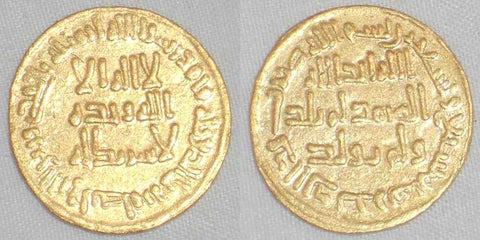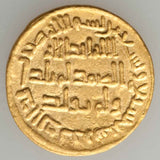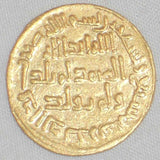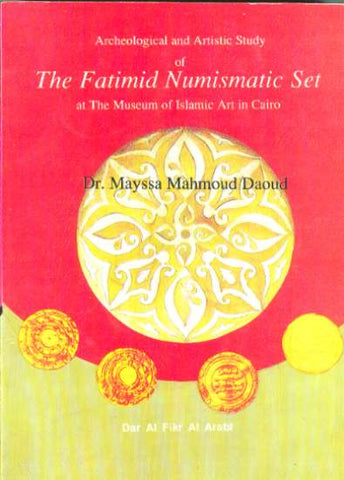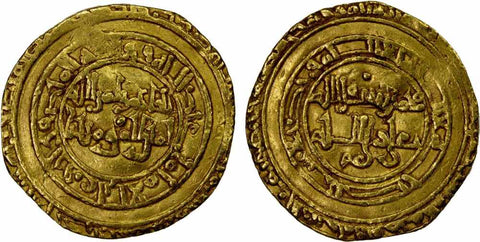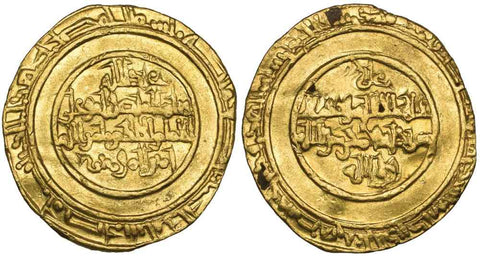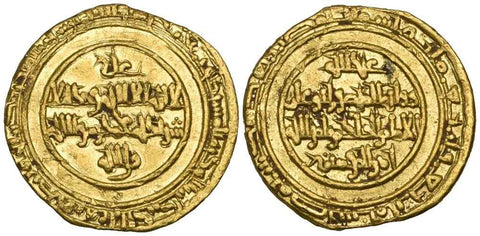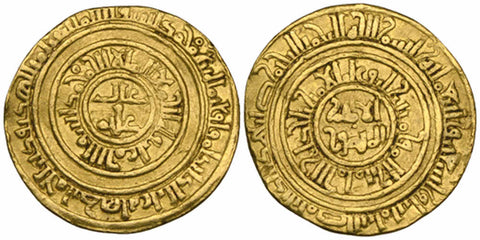716 Islamic Coin Umayyad Gold Dinar Caliph Sulayman Ibn Abdel Malik Ibn Marwan
Description: Umayyad Gold Dinar struck in 97 AH (716 AD) during the reign of the Caliph Sulayman ibn Abd al-Malik b. Marwan. Sulayman ruled the islamic world in the period 96-99AH (715-717 AD). This is an example of reformed Islamic coinage instituted by Abdel Malik b. Marwan in 77 AH. Please carefully review the scan presented as it is part of our description.
Date: Struck in the year 97 AH or 716 AD.
Mint: Not mentioned on the coin.
Size and Weight: This is a gold dinar, weighs ~4.2 grams and is ~20 mm in diameter.
References: It is Album 130, Bernardi 43, and is listed in Lane Poole Catalogue of the Collection of Arabic Coins Preserved in the Khedivial Library in Cairo Egypt as number 27.
Condition: I would grade this coin as a nice very fine or better with a well centered strike and beautiful Calligraphy. The coin is beautiful and is much better than the scan suggests. A beautiful and very readable coin of the highest quality to add to your collection. Please see scans for additional condition information.
Historic Perspective: The Muslim Arabs used existing gold and silver coinage in lands they conquered. At that time the nascent Islamic nation did not have a monetary system and did not strike neither gold nor silver coins, instead the conquering Arabs used the Byzantine monetary system already existing in Egypt for most of the gold coins and the Sassanian monetary system already existing in Iran for most silver coins with minor modifications. In 77 AH (699 AD) Abd al-Malik Ibn Marwan the Umayyad caliph instituted a monetary system and began striking the first Islamic coins including the gold Dinar. The dinar weighed 4.25 grams, or one mithqal, of the highest purity gold possible. At the time the center of power and the main gold coin mint was located in Dimishq (current day Damascus in Syria).
Date: Struck in the year 97 AH or 716 AD.
Mint: Not mentioned on the coin.
Size and Weight: This is a gold dinar, weighs ~4.2 grams and is ~20 mm in diameter.
References: It is Album 130, Bernardi 43, and is listed in Lane Poole Catalogue of the Collection of Arabic Coins Preserved in the Khedivial Library in Cairo Egypt as number 27.
Condition: I would grade this coin as a nice very fine or better with a well centered strike and beautiful Calligraphy. The coin is beautiful and is much better than the scan suggests. A beautiful and very readable coin of the highest quality to add to your collection. Please see scans for additional condition information.
Historic Perspective: The Muslim Arabs used existing gold and silver coinage in lands they conquered. At that time the nascent Islamic nation did not have a monetary system and did not strike neither gold nor silver coins, instead the conquering Arabs used the Byzantine monetary system already existing in Egypt for most of the gold coins and the Sassanian monetary system already existing in Iran for most silver coins with minor modifications. In 77 AH (699 AD) Abd al-Malik Ibn Marwan the Umayyad caliph instituted a monetary system and began striking the first Islamic coins including the gold Dinar. The dinar weighed 4.25 grams, or one mithqal, of the highest purity gold possible. At the time the center of power and the main gold coin mint was located in Dimishq (current day Damascus in Syria).

